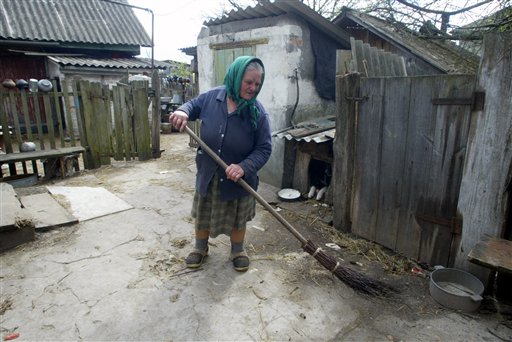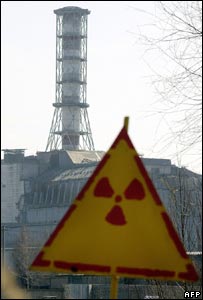
73-year old Maria Urupa cleans her kitchen
garden in a village near Chernobyl nuclear power plant on May 10, 2007.
Two decades after an explosion and fire at the nearby Chernobyl nuclear
power plant sent clouds of radioactive particles drifting over the fields,
natural wildlife is returning to the area, and Maria Urupa says the wilderness
is encroaching.
Two decades after an
explosion and fire at the Chernobyl nuclear power plant sent clouds of
radioactive particles drifting over the fields near her home, Maria Urupa
says the wilderness is encroaching. Packs of wolves have eaten two of her
dogs, the 73-year-old says, and wild boar trample through her cornfield.
And she says fox, rabbits and snakes infest the meadows near her tumbledown
cottage.
"I've seen a lot
of wild animals here," says Urupa, one of about 300 mostly elderly
residents who insist on living in Chernobyl's contaminated evacuation zone.
The return of wildlife
to the region near the world's worst nuclear power accident is an apparent
paradox that biologists are trying to measure and understand.
Many assumed the 1986
meltdown of one reactor, and the release of hundreds of tons of radioactive
material, would turn much of the 1,100-square-mile evacuated area around
Chernobyl into a nuclear dead zone.
It certainly doesn't
look like one today.
Dense forests have reclaimed
farm fields and apartment house courtyards. Residents, visitors and some
biologists report seeing wildlife - including moose and lynx - rarely sighted
in the rest of Europe. Birds even nest inside the cracked concrete sarcophagus
shielding the shattered remains of the reactor.
Wildlife has returned
despite radiation levels in much of the evacuated zone that remain 10 to
100 times higher than background levels, according to a 2005 U.N. report
- though they have fallen significantly since the accident, due to radioactive
decay.
Some researchers insist
that by halting the destruction of habitat, the Chernobyl disaster helped
wildlife flourish. Others say animals may be filtering into the zone, but
they appear to suffer malformations and other ills.
Both sides say more
research is needed into the long-term health of a variety of Chernobyl's
wildlife species, as governments around the world consider switching from
fossil fuel plants, blamed for helping drive global climate change, to
nuclear power.
Biologist Robert J.
Baker of Texas Tech University was one of the first Western scientists
to report that Chernobyl had become a wildlife haven. He says the mice
and other rodents he has studied at Chernobyl since the early 1990s have
shown remarkable tolerance for elevated radiation levels.
But Timothy Mousseau
of the University of South Carolina, a biologist who studies barn swallows
at Chernobyl, says that while wild animals have settled in the area, they
have struggled to build new populations.
Far from thriving, he
says, a high proportion of the birds he and his colleagues have examined
suffer from radiation-induced sickness and genetic damage. Survival rates
are dramatically lower for those living in the most contaminated areas. |
In explaining their
starkly differing views, Baker and Mousseau criticize each other's studies
as poorly designed.
But their disagreement
also reflects a deeper split among biologists who study the effects of
exposure to radiation. Some, like Baker, think organisms can cope with
the destructive effects of radiation up to a point - beyond which they
begin to suffer irreparable damage. Others believe that even low doses
of radiation can trigger cancers and other illnesses.
In the Journal of Mammology
in 1996, Baker and his colleagues reported that the disaster had not reduced
either the diversity or abundance of a dozen species of rodents - including
mice, shrews, rats and weasels - near the Chernobyl plant.
"Our studies show
that a dynamic ecosystem is present in even the most radioactive habitats,"
they wrote.
Baker's group reported
sighting red fox, gray wolf, moose, river otter, roe deer, Russian wild
boar and brown hare within a six-mile radius of the plant - the most heavily
contaminated area.
Genetic tests showed
Chernobyl's animals suffered some damage to their DNA, Baker and his colleagues
reported. But they said overall it didn't seem to hurt wildlife populations.
"The resulting environment
created by the Chernobyl disaster is better for animals," Baker told
the Associated Press in a phone interview.
Critics point out that
Baker's work has been funded by the U.S. Department of Energy, which some
view as pro-nuclear. Baker defended the government connection, saying,
"We have never been asked to come up with any specific conclusions,
just do honest work." He also said his work has been peer-reviewed.
Mousseau and his colleagues
have painted a far more pessimistic picture.
In the journal Biology
Letters in March, a group led by Anders Moller, from Pierre and Marie Curie
University in Paris, said that in a study of 7.700 birds examined since
1991 they found 11 rare or unknown abnormalities in a population of Chernobyl's
barn swallows.
Roughly one-third of
248 Chernobyl nestlings studied were found to have ill-formed beaks, albino
feathers, bent tail feathers and other malformations. Mousseau was a co-author
of the report.
In other studies, Mousseau
- whose work is funded by the National Science Foundation and National
Geographic Society - and his colleagues have found increased genetic damage,
reduced reproductive rates and what he calls "dramatically" higher
mortality rates for birds living near Chernobyl.
The work suggests, he
said, that Chernobyl is a "sink" where animals migrate but rapidly die
off. Mousseau suspects that relatively low-level radiation reduces the
level of antioxidants in the blood, which can lead to cell damage.
"From every rock
we turn over, we find consequences," he told the Associated Press in
a phone interview. "These reports of wildlife flourishing in the area
are completely anecdotal and have no scientific basis."
While the experts debate,
Maria Urupa, harvests tomatoes from her garden, buys fish from the nearby
Pripyat River and brews moonshine vodka.
Eating locally produced
food is risky, health experts agree, because plants and animals can concentrate
radioactive materials as they cycle through the food chain. Do she fear
the effects of her exposure to radiation?
"Radiation?
No!" she said. "What humans do? Yes." |
